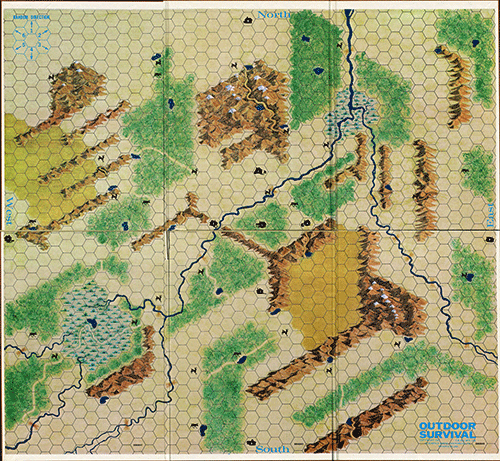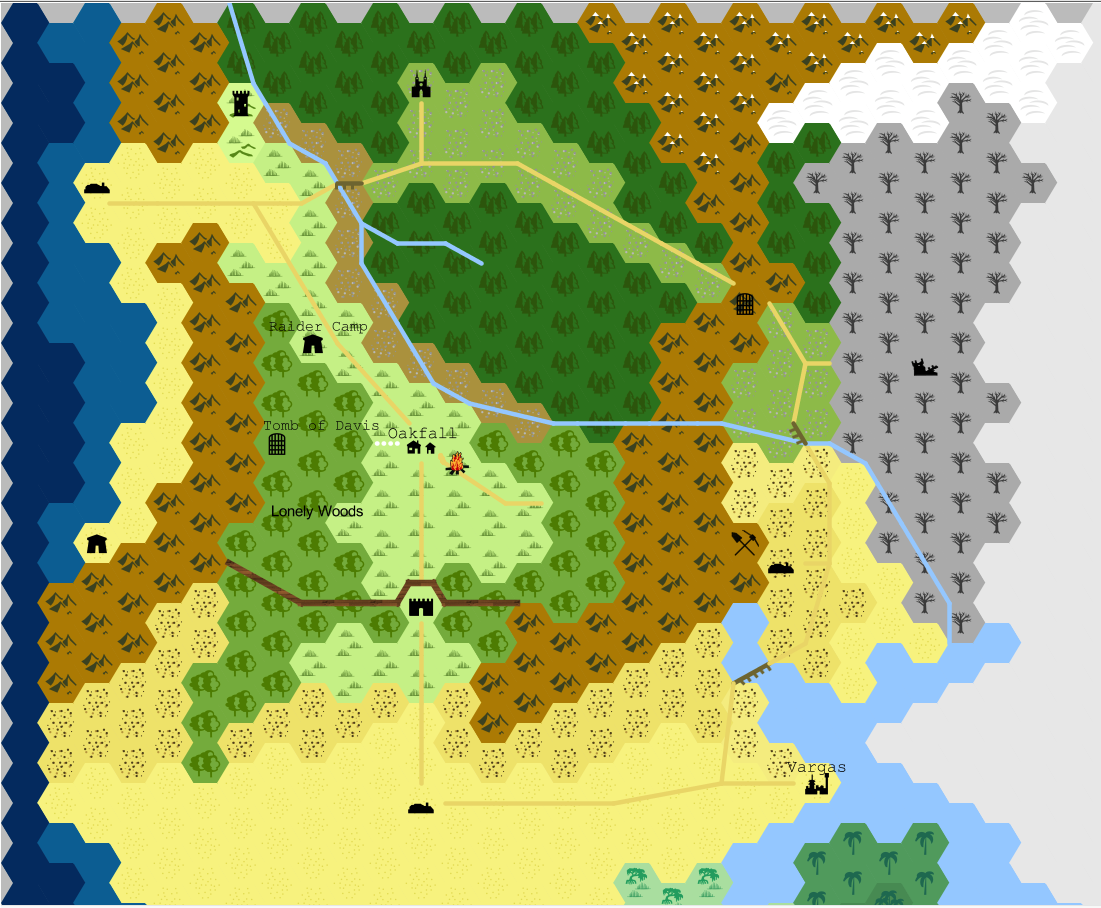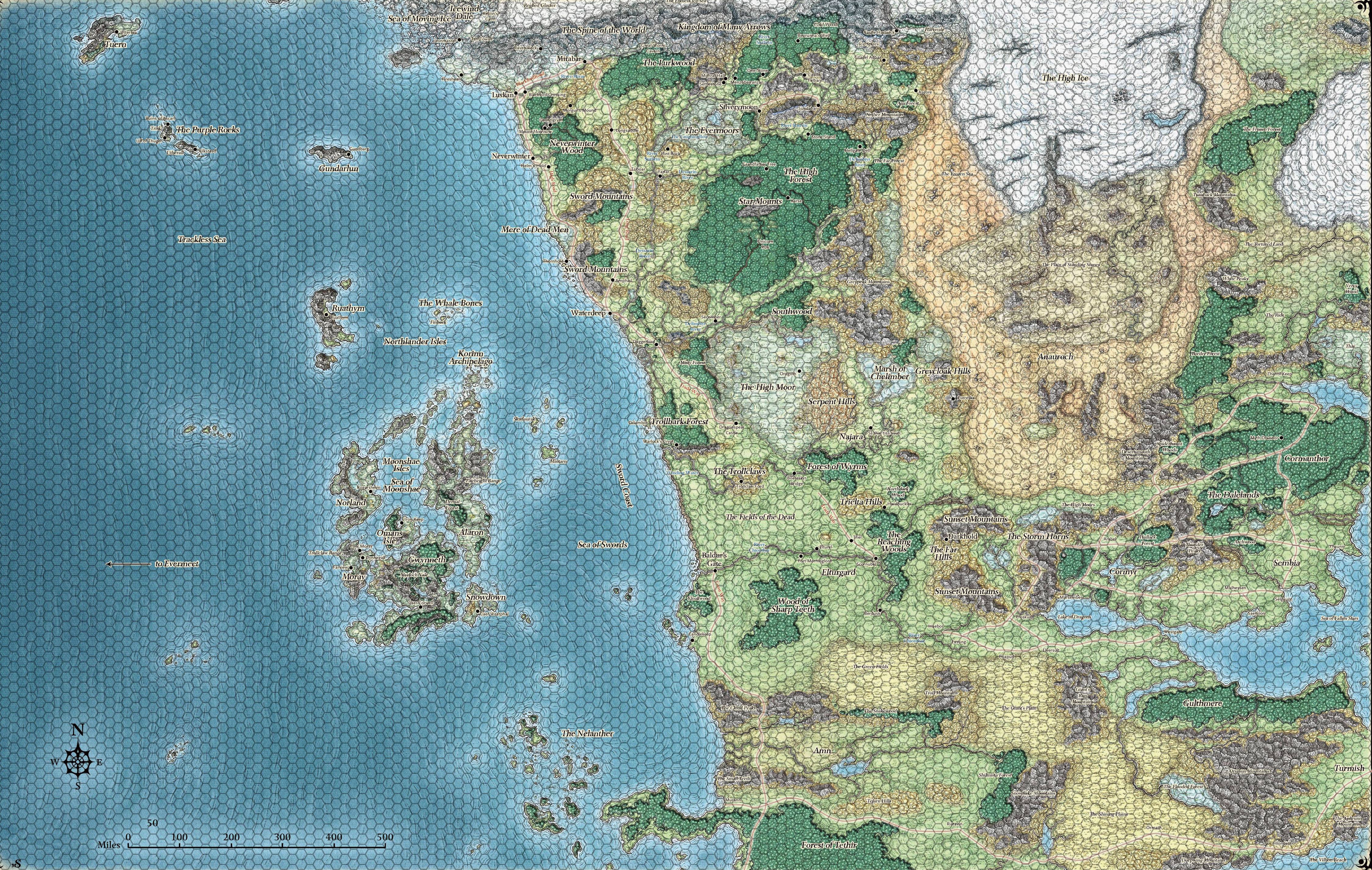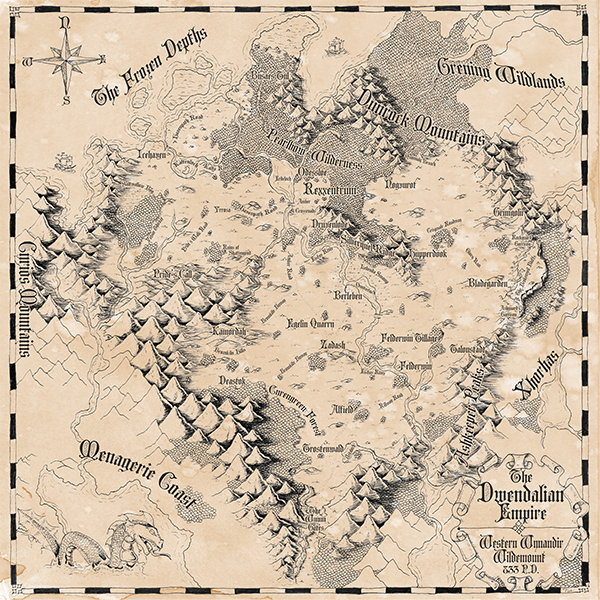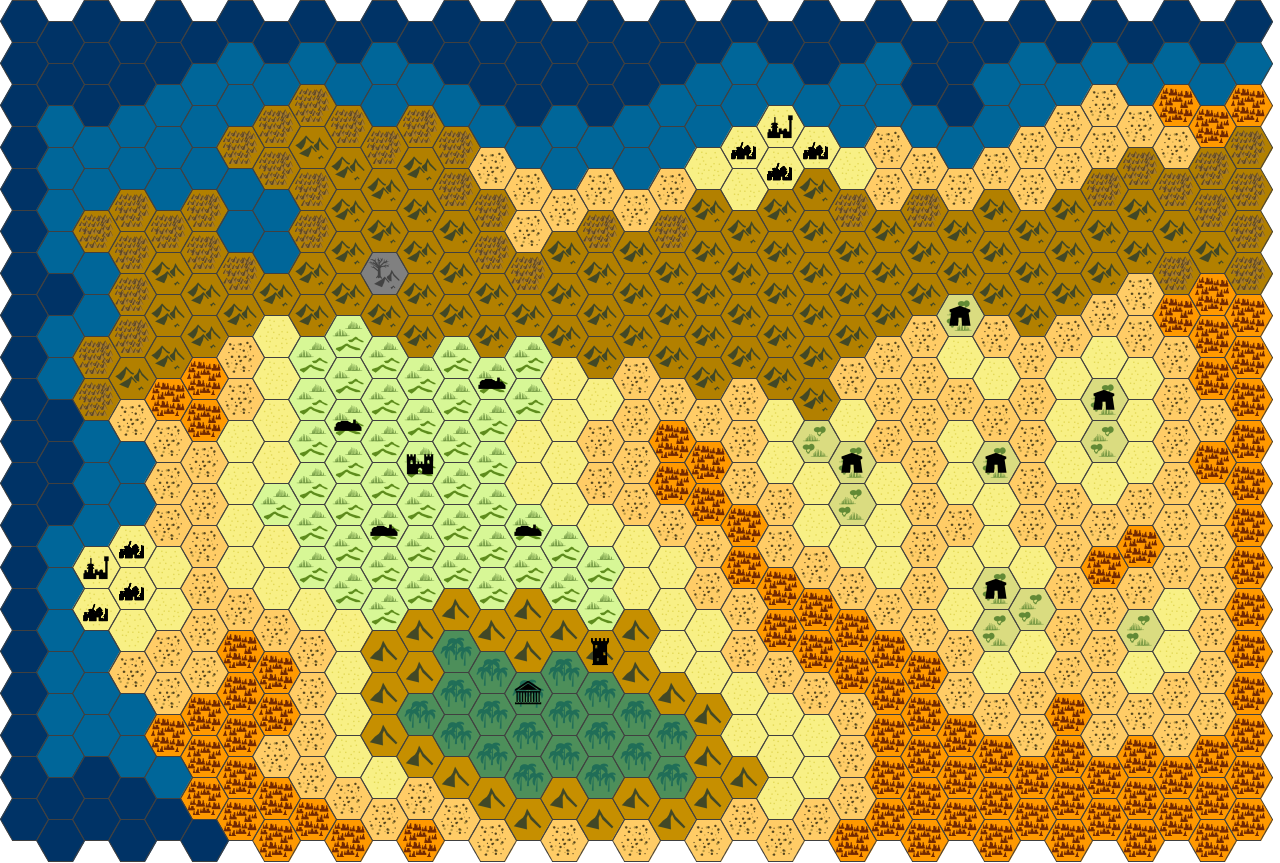A guide to Hexcrawling, Part 1
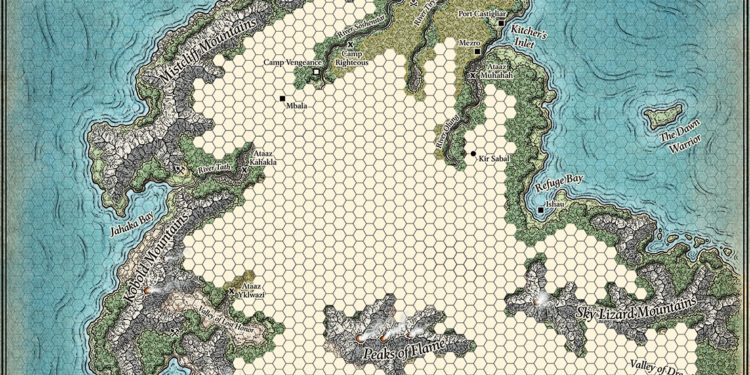
Truth is that if you have already played videogames such as Civilization, board games like Catan, or opened one of the D&D 5e modules, you have already seen some sort of hexmap. These typically appear to show great maps to explore. However, what you may not know, is that they have been used for several years and people might continue to do so. Want to know why?
Hexcrawls are specific tools that come all the way from 1st Edition. They didn’t even come from D&D but from some other game from that time. In order to talk about them, their good and bad aspects, and how to properly use them, let’s go back in time for a bit and explain in detail what they are.
What exactly is a hexcrawl?
Hexcrawling is the action of traveling through hexes. But what is a hex? Hexes are hexagonal shapes used in games to work as an abstract representation of terrain. Their key factor is that by having this shape, they show in a better manner how an army unit, player character or player token can move. They do so by traversing any of its six sides.
Hexes do also abstract distance, usually making each hex be about 24 miles in length (one day march by foot). Therefore, one can easily see how much a group of players can travel in a week’s time. Additionally, they can be used to indicate different biomes: One hex may be desert filled, but the one next to it could be a mountain region or grassland.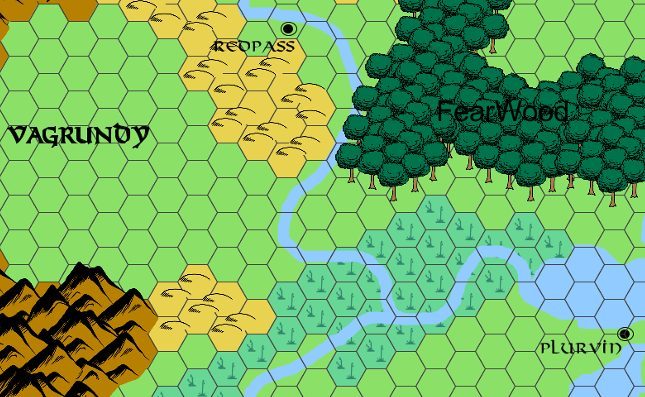
Notice that the image shows key points from the world, such as cities and important forest sections. Hexmaps normally mark them down, as well as interesting locations or findings. Treasure maps are not actually hexmaps, but do show these important spots in a very similar way hexmaps do.
Thus, hexcrawling is the open-world adventuring that is done by exploring what lies in every hex traversed, while going from a point A to a point B.
Hexcrawling origin for D&D
At first, when D&D was still on its roots from first edition things were much different. In order for players to explore a terrain or move from one location to the entrance of the dungeon provided in a module, they would have to use a separate game. Yep! Gary Gygax asked players to get the Outdoor Survival board game by Avalon Hill in order to use it as a world map.
Back at the start of this awesome hobby, players would have a home base in cities. From there, they would have to travel to a dungeon by using these hexmaps I was talking about, grab all the loot and return to city. The adventure was both the travelling and dungeon-delving as a whole. There was a high chance for players to find random encounters on the way, making the world not only feel more real and untamed but also to take away some of the players’ sacred resources.
Hexcrawling in this manner introduced a whole new survival aspect to the game. Food, water, hunting, foraging, pillaging abandoned places to survive. In order to get to the dungeon and back every little resource the party had and could find was vital for survival. Many people may not like this and come to play D&D for a completely different reason. However, I speak a bit about how great I find this to be in this article if you want to check it out. Give it a read if you can, and you may end up wanting to add some hexcrawling into your games.
Biomes
Each hex in a map shows a different biome. If you are going to be making a hexmap try not to create unbelievable things, such as having a desert land be next to a tundra region. If you do have a good reason for it to be that way, such as it being the result of a magic war long ago, then go ahead.
Learn a bit about each region on the internet to give better descriptions of how it feels to be in those areas. Wikipedia and documentaries are your best friends for this. Jungles, for example, tend to be extremely humid regions, while trekking on mountain regions leaves you breathless after a short while. Give the players the possibility to choose to travel to someplace through one biome or another. This can completely change the next sessions, maybe the entire story route. The Moria mines section in the Lords of the Rings is by far the perfect example of this.
Consider creating a weather table for each biome or zone in your maps. Believe it or not, weather does not only add a whole new layer of immersion to the game but provides extremely interesting aspects as well. More rules on how it affects the game can be found on page 110 from the DMG.
Random Encounters
Hexcrawls needed more realism, something that could harm the player characters in one way or another while they travel. That’s why every time the group of players moves from one hex to an adjacent one a random encounter roll is made. There is a chance nothing happens, which can vary from one location to another, while some other specific hexes already have defined encounters in them. As an example, an obelisk could be drawn in one of the spaces in the map, meaning that if the PCs enter that hex they are going to find an immense one for you to use as an encounter.
Notice that when I say ‘encounters’ what I am really trying to say in these exploration and/or navigation through the world is that a new discovery or interesting find can appear in the next hex. That way, a cave that contains a long-forgotten dungeon is also considered an encounter, in the same way finding a giant Galapagos-size turtle (not necessarily a hostile creature) can be.
These may start to get a bit repetitive after you find yourself with the same 2d6 goblins. In addition, as these don’t move the plot forward in any way, players may start to get frustrated. I plan to fix this a bit without fully removing the travel from point A to point B. As we’ve seen in Lords of the Rings, the journey can be a huge part of what makes the adventure so great. Today I may only scratch the surface, but stay tuned for the next part on how to make hexcrawls better by improving these random encounters.
In case you need some extra encounters to add to your hexcrawls, might I point you in the right direction?:
- Take a look at my Monthly Encounters Collection: Here is the last one I made so far
- What about grabbing one from my Let’s build a Lair collection?: Here are some monsters with their respective lairs
- Need some naval or piratey ones? These 20 Sea Encounters or Pirate Port Town encounters might fit your needs.
Easy to use
Even though many people don’t really like using hexcrawls, they still remain as one of the easiest methods to track player progress in exploration. That’s why WotC remains to make use of them as they did with Out of the Abyss, Storm King’s Thunder and Tomb of Annihilation. Many do say that they take away immersion by showing the characters an abstract view of the world, while also making them move in a rather videogamey way. While I partly agree with this statement, I do believe that giving the players a full map of the world around them, as well as the ability to track their own progress, grants them a huge sense of freedom. Players may get intimidated if not done properly though.
For a hexmap to work great, we need to point some details from it, or have NPCs help out the players by drawing interesting locations in the map. To use a popular example, if you have ever watched Season 2 of Critical Role you will see how happy it makes the players get to see maps from the regions they are in. Why is this? These maps not only show the cities, or villages from the continent but also interesting places such as caves or huge trees. While this is not a hexmap, it does perfectly show what you need to include in them, as these small details are what will make your players start moving, maybe just because they are curious what one of those things is. To see more of these maps for some inspiration, consider following Deven Rue’s work or give a read to my article about mapmaking and their importance.
But why is it that hexmaps remain as one of the most used maps for exploration purposes? That’s because of their ease to track progress. The players march for four days through the jungle, until they find a weird but fantastic flying-monkeys community. They mark it in the specific hex they are in and continue traveling. On their way back, they can easily see in the map how much terrain they need to cover to get to this city again to gather resources, in terms of days. No calculations needed, no weird compasses, just count the number of hexes the players traveled through.
Last but definitely not least, one of their greatest benefits is for DMs. How much do you need to plan for the next session? Take a look at where the players are located and plan out the following 4 hexes (or maybe more, as it depends on the length from your sessions) the players say they were going to travel. Do they make a detour and go somewhere you didn’t expect? That’s when you can pick one of the encounters from the list you have for emergencies. There is a huge amount of them you can find here in Tribality for free, and some more on DM’s Guild.
Tools to use
In case you want to easily create a hexmap there are many ways to do so. You could go buy a huge paper full of hexes and start drawing in it, but that may be too much work. There are tools online you can use for creating them:
Hexographer
Probably the most popular hexmap making tool. Partly, it became really popular with Matt Colvile’s Collabris series (which you should definitely watch). However, it was its ease to use (as well as having lots of free tools to use) that made it so popular. Check it out by clicking THIS LINK.
Hextml
Want to create a hexmap online without the burden of having to download and install some software? That’s exactly what Hextml is for! It really surprised how versatile and easy to use this application is. What’s more, you can even draw hexmaps with a friend at the same time, in the same way Google Docs coworking works (haven’t tried that though as I never had the need to edit a hexmap with another person). In case you want to try it out, click THIS LINK.
Conclusion
In conclusion, hexmaps are an excellent way to track exploration campaigns or Indiana-Jones-like ones. Even though they may be a bit controversial and not liked by some players and DMs, I suggest you give them a try. I’ll be making a guide on how to run better hexcrawl games in the following days (click here), but I wanted to give this introduction to the topic first. In other words, stay tuned!
Have you ever run a hexcrawl like adventure or campaign? Do you have nice memories you would like to tell about your earlier edition times with them? Is there something I didn’t mention you dislike or love about hexcrawls? Let me know in the comments below!
If you liked this
Want to add in more encounters to your hexcrawls? Why not add in some chaotic blood moon to trigger unusual ones? Check out this article in which I talk about these sort of weird happenings!

